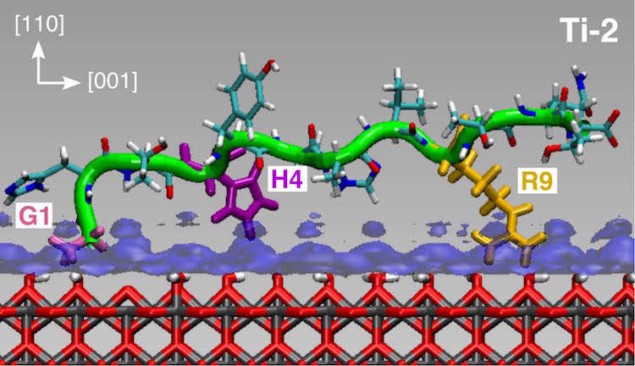
Titanium-based materials are widely employed in medical implants because they are biocompatible and have excellent mechanical and corrosion properties. Dental implants are a good example because titanium quickly ossointegrates into surrounding tissue, thus building a good barrier to bacterial infection. In recent years, researchers have discovered that coating the surface of titanium materials with biologically active molecules, such as peptides, improves ossointegration and so further reduces the probability of the implants loosening and falling out. Scientists at Deakin University in Australia have now made an important advance in this field by studying how positively-charged calcium ions present at the interface between titanium oxide and tissue affect how well certain peptides bind to the titanium.
Their experiments and calculations reveal that the calcium ions act as “bridges” between the titanium oxide and aspartate (Asp8), which is a residue within one of the titanium-binding peptides studied. The ions thus improve titanium-bone adhesion.
The researchers, led by Tiffany Walsh, used molecular dynamics simulations to model the behaviour of two titanium-binding peptides, known as Ti-1 and Ti-2, in 0.15 M solutions of calcium chloride and sodium chloride (as a control). They also used a Hamiltonian-based “replica exchange with solute tempering” technique that they previously developed in their lab that simulates the interactions between the different molecules in the system. The simulation cell comprises one peptide chain, a five-layer titania slab (containing 6100 atoms) solvated with 6952 water molecules and calcium and chloride ions. They backed up their findings with experimental quartz crystal microbalance measurements of how well titania binds to the Ti-1 and Ti-2.
The Deakin University team used supercomputing resources provided by the National Computational Infrastructure, based in Canberra, to carry out its simulations.
“In simple terms, we used computer models to provide us with the most detailed simulations of the interface between molecules that could be found in the body and the kinds of surfaces that you might find on the exterior of a joint implant,” explains Walsh. “We hope these detailed simulations will help other research groups understand how these implant surfaces might be improved to deliver a more reliable implant.”
Bridges between the titanium and asparagine
The researchers found that positively charged calcium ions helps Ti-1 adhere to the surface of titanium (which is negatively charged) by acting as bridges between the titanium and Asp8. This process then enhances the adhesion of other residues such as Lys12 to the titania surface. In contrast, the Ti-2 does not adhere so well.

Nanosilicates stimulate growth of bone and cartilage tissue
“Our work contributes to the long-running and ongoing effort to improve load-bearing implant materials,” Walsh tells Physics World. “What is more, the simulation procedure we used is generalizable to any complex molecule interacting with a complex solid surface in the presence of a solvent, so the type of problem this kind of modelling can address can range from catalysis and energy applications through to self-assembly.”
So, where next? Walsh says that she would like to use the findings from this study to test chimeric molecules containing two distinct binding domains, one at either end of a molecule. “These molecules could contain one domain for titania recognition and another that could carry out another function – for example, one that would bind integrins, transmembrane receptors that facilitate cell-extracellular matrix (ECM) adhesion.”
The research is detailed in a special issue of the AIP journal Biointerphases that highlights work by women in the field of biointerfaces science and engineering.



